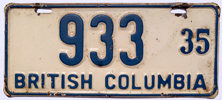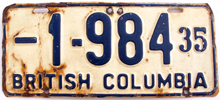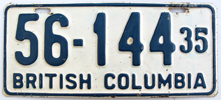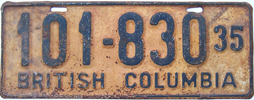|
British
Columbia Passenger License Plates
|
||||||||||||||||||||||||||||||||||||||||||||||||||||||||||||||||||||||||||||||||||||||||||||||||||||||||||||||||||||||||||||||||||||||||||||||||||||||||||||||||||||||||||||||||||||||||||||||||||||||||||||||||||||||||||||||||||||||||||||||||||||||||||||
Quick Links: |
If the years between 1918 and 1930 are the "Patronage Era" (1918-30), the period between 1931 and 1976 can fairly be described as the "Prison Era" when BC plates were manufactured by inmates at Oakalla Prison in Burnaby. |
* * * * * |
When the Sun reported the story, the government had already purchased the necessary equipment in the form of "two stamping presses, a shear, a conveyor, a baking oven and other minor items" and was in the process of moving it to Oakalla. The source of the equipment purchased by the province was none other than J.R. Tacey & Son, who had previously won the contracts to produce BC license plates from the previous Liberal government between 1918 and 1929. The Sun reported that "information of this transaction reached [it] from Conservative circles, which are in an uproar of protest over the deal." These disgruntled Conservative party members aired their many grievances to the Sun, including the failure by the government to consult with the local executive about the move, a poor approach to job creation in hard economic time and most important of all; the impact on a local business aligned with the Party! The value of the contract for the 1930 license plates was estimated to be approximately $15,000 (and increased annually) and had been awarded to the Thompson Heating and Ventilating Company following the election of a Conservative government in 1928. |
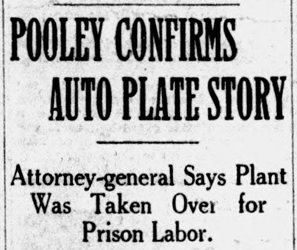 |
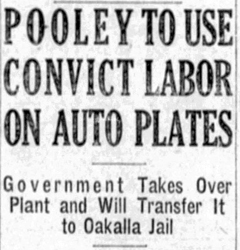 |
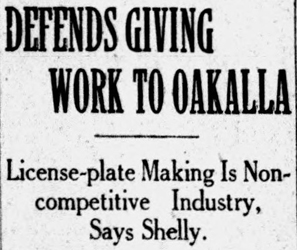 |
On the defensive after its plan was revealed by its own party members, the provincial government attempted to manage the fallout by emphasizing the "improvement in prison morale" that would result from inmates having meaningful work making license plates. The Attorney General, Robert Pooley, also made the point of closing his remarks to the press by revealing that "the late Liberal government had this matter in contemplation ... [but] the cost of the plant, about $70,000, had acted as a deterrent." The Conservatives, however, had obtained a plant "at a reasonable figure" and, by the way, had followed the Liberal's plans in all other ways. William Shelly, the Minister of Industries and MLA for Vancouver City, promoted the estimated savings of $5,000 a year to taxpayers by moving license plate production to Oakalla, that license plate production was not a competitive industry so no private firms would be impacted (Tacey having sold his equipment and Thompson seemingly never having had any equipment) and, by the way, it had the support of the local sheet metal workers union who had written a letter to that effect. Left unsaid was the economic backdrop following the Wall Street Crash the previous Fall and the government's attempts to now find money wherever it could, including the collection of all industrial loans made over the previous decade. J.R. Tacey & Son had been the recipient of such a loan for $20,000 in 1920 as it was gearing up it license plate facility to compete for contracts with other provinces, and had only repaid $6,000 of it. The deal with the province wiped the books clean. Despite the government's assurances about the merits of the plan, there remained "considerable opposition from members of the [Conservative] party to utilizing prison labor in competition with civilian industrial operation." It was reported that George Thompson, "absolutely refuses to make any statement for publication" about losing the license plate contract. The response from labour was wholly predictable: |
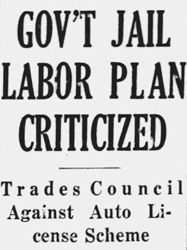 |
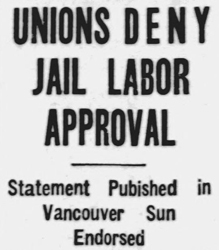 |
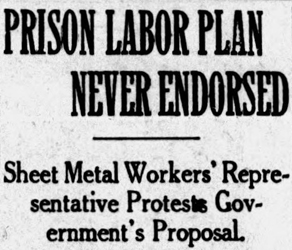 |
| Officials from the Trades and Labor Council and of the Sheet Metal Worker's Union visited a local newspaper the following morning to correct the allegations made by Shelly, specifically the suggestion that "the whole transaction has received the approval of the Sheet Metal Workers". The Secretary of the Union, D. Macpherson, made an "indignant denial" and shared his recollection of the matter; |
I was approached by Mr. Fred Tacey of the firm J.R. Tacey & Sons, who stated that his company, which had made the license plates prior to 1929, had an opportunity to dispose of the machinery privately. Mr. Tacey asked me if the union had any objections to disposing of the machinery and if not to give him a letter to that effect as it would help the sale. None of our men were engaged in this class of work and I gave him a short letter but by no stretch of imagination could its contents be construed that I was endorsing prison labor. As a matter of fact, I did not know that it was the intention to use the machinery to manufacture the plates in prison. |
| The Secretary of the Building Trades Council, W. Page, summed up labour's general position on the matter as follows: |
Labor has always been opposed to prison contract labor, but we do not propose to be mixed up in political patronage discussions. Our observation has shown that the license plate contracts have been handed from one to another as political parties came into power. While we realize the necessity of having some employment for men so unfortunate as to be in prison, such as taking care of grounds and so on, we are absolutely opposed to them working on article in competition with legitimate business firms. |
Not missing an opportunity to exact some retribution, Macpherson disclosed that Fred Tacey had suggested that "the total cost of the operation for a year when the plates were made in the Tacey plant was approximately $2,000, or at most $2,300." This, of course, would be significantly below the contracts that Tacey had signed with the provincial government throughout the 1920s. While it is unlikely that $2,300 was the actual cost to Tacey to produce license plates, remembering that other companies bid comparable to Tacey, Macpherson was underscoring the degree to which the license plate contract was a way to funnel some public monies to political allies (e.g. "patronage"). Meanwhile, the infighting in Vancouver Conservative circles over the plan reached a fever pitch: |
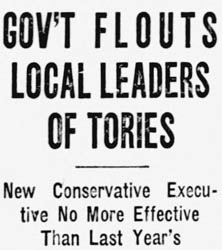 |
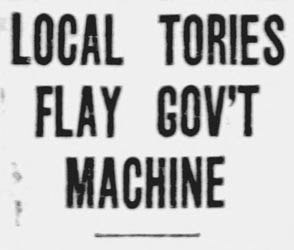 |
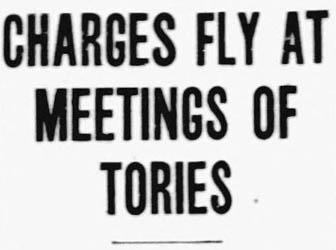 |
The Vancouver Conservative Association, whose Division 11 was led by none other than George Thompson, held a "lively discussion on patronage" and the challenges of "securing more government jobs for recognized party adherents" in their area when "the cabinet ministers 'paid no attention to them.'" It was noted that "since the change of government they had received only one permanent government job for a member, and they they considered themselves grossly insulted" as a result. This state of affairs was further attributed to a "failure of the Vancouver members of the legislature to consult with the association or its executive" which was creating "clique rule". The decision to use prison labour at Oakalla to make license plates, thereby aggravating existing unemployment problems in the city was decried and a resolution passed by the Association declaring itself "absolutely opposed to a policy of prison-made goods." Given economic circumstances, the sound and fury expressed by the local constituency associations did not sway the government from its path and Oakalla became the home of license plate production in British Columbia for the next 45 years. |
Unfortunately, it amounts to not much more than a few sentences; We come to the question of employment ... Every inmate who works is given 10 cents a day. He has at least some money in his pocket upon the day of his discharge. The inside work consists of a tailor and shoe shop and a new industry of making license plates ... The license plate industry has just been started a few months, and upon my release was employing twelve men.
The paint application machine looks more like a pasta maker with very limited capacity. It was reported that prisoners could make approximately 1,000 sets of plates a day with a crew of 12 working. |
The colour of the 1931 plates were described as going "back to plain tastes ... [with] the bright yellow and red license plates [used in 1930] being replaced with the more staid colors of black and white." In other media reports, it was stated that the colours were "severe black figures and letters on a white background." The first shipment from the Oakalla Plate Shop reached the Vancouver Court House on November 21, 1930, a mere 8-months after production was transferred to the prison. |
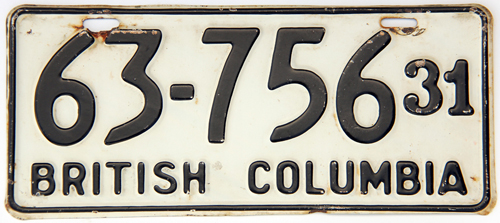
| 1931 | |||||||||||||||||||||||
1-digit
|
|
||||||||||||||||||||||
In December of 1930, the Vancouver Province newspaper renewed its campaign to convince the provincial government to change the licensing year. It noted that, this year, "money, for all its cheapness, is not very plentiful, even with the owners of motor cars, and after Christmas, it will be less plentiful than it is now. It is suggested therefore, that, in view of circumstances, the authorities at Victoria be a bit lenient with motorists and allow them to use their o plates until, say the middle of March." |
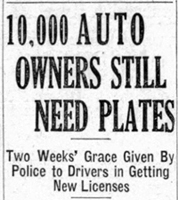 |
|
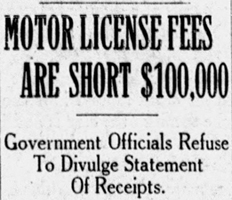 |
In the cartoon at left, a motorist is shown, first, with his 1929 license plate swearing he'll get his plates earlier in 1930. In 1930, he says he'll be earlier in 1931 and this is followed by a question mark for 1931. A year after the Wall Street Crash, the anticipated full rush usually experienced at motor licensing offices had not happened, which was attributable to the weak economy. It was subsequently estimated that, in the Victoria area, about 1/3 of vehicle owners drove their cars as long as they could into January without having to pay for new plates, with some waiting until April 1st when licensing fees were reduced by 25% before registering. In Vancouver, receipts from the sale of license plates was down $100,000 from the same time in 1929. |
In what can only be seen as an absolutely appalling decision - regardless of the era it was made in - someone at the Provincial Police decided the best way to dispose of these license plates was to throw them into the ocean! Worse, the chosen site was an official "Graveyard" previously used by the police to dispose of license plates as well as firearms used as evidence in various Vancouver court cases. While we don't know where the provincial "Police Motor Launch No. 3" was stationed, the "Graveyard" was situated off Atkinson Point, which is known for its lighthouse. |
 The Provincial "Police Motor Launch No. 3" cruising the waters of Howe Sound in the 1930s. |
|
 |
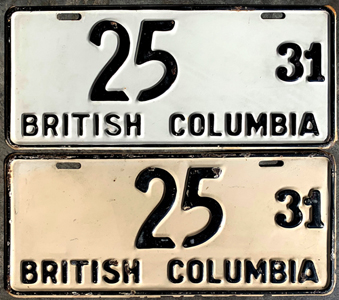 |
Davis tried to get the No. 25 from every state, province and territory in North America and then affixed as many as he could to his car, which we drove around the continent to promote his "Good Roads Campaign". In some years, it can be hard to tell which plates went to Davis and which stayed in the province (such as with the 1930 and 1933 plates shown above left). But, in other years, such as the 1931 plates shown above, it is believed that the version with the No. 25 off-set to the left (above plate at right) were issued to Davis. To learn a little more about Davis' "Good Roads Campaign", Click Here! |
* * * * * |
The colours would be white on maroon, however, other media reports from the time describe the background to be "chocolate". |
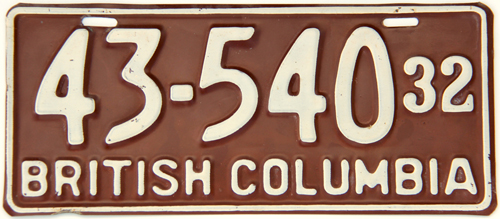
| 1932 | |||||||||||||||||||||||
1-digit
|
3-digit
|
|
|||||||||||||||||||||
Despite the slack demand for vehicle registrations throughout 1931, the Provincial Police retained its optimism that vehicle registrations would continue apace as in the 1920s. As a result, the license plate order for 1932 was increased by 4.3%, or 5,000 additional plates, which brought the total of 120,000 sets. This confidence would prove to be misplaced as registration numbers took a precipitous drop over 1931, ultimately declining 7.1% and prompting calls for action: |
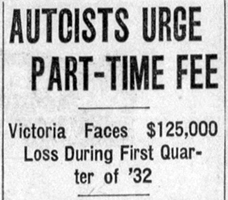 |
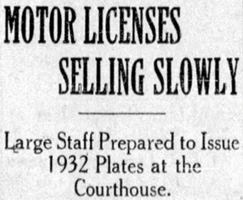 |
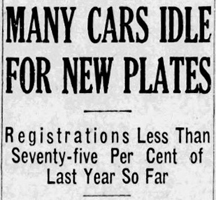 |
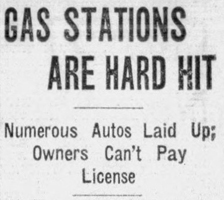 |
This included the call first heard in the 1920s to provide flexibility in the fee structure so that motorists did not have to pay the full year license by January 1st. The benefits of such an innovation were seen to be multiple: |
|
|
|
|
 An empty gas station (albeit one being staged for a nice photo) was a concern as motorists took their cars off the road throughout 1932. Ironically, by the late 1920s, construction of Shell gas stations in Vancouver had become an important line of business for J.R. Tacey & Son. |
It was reported (incorrectly), that in Washington State, "the 1931 license plate remains on the car for identification purposes and a windshield sticker is appended as a receipt for the one quarter's license fee." As will be seen, it was Oregon that had provided this option to its motorists in 1930. On January 7th, demand for license plates in New Westminster was 50% below what it had been at the same point in 1931 and in Victoria 42% fewer cars were registered on January 18th. To try and spur demand, the Provincial Police announced that they would be enforcing the need to be registered and displaying 1932 plates by January 15th. Underscoring the state-of-affairs, a week later over 500 motorists in the Vancouver area had been summoned to appear traffic court for the offence of driving without 1932 license plates. Gas station owners claimed their business was down 40% as a result of all the vehicles being taken off the road with one garage proprietor declaring the solution to be "for the Provincial Government to pass the necessary legislation to permit car owners to operate their vehicle for several months on last year's license plates."
This provided a 17-day bonus and it was hoped that "with the present alluring spring weather and the approaching Easter holidays offering a further inducement, it is anticipated that there will be a rush of motorists for license plates." |
| The Temporary "Extension" License |

So worried was the Imperial oil company that even more cars would be taken off the road come January 1st and the new licensing year that it offered to advance $500,000 to British Columbia and $250,000 to Saskatchewan if these governments amended their licensing year and allowed motorists to continue driving with their 1932 license plates until April 1st of 1933 (no joke!). Imperial estimated that $500,000 would be the amount of revenue the government would forgo in licensing fees be extending plates by 3-months as well as possibly lost gas taxes from vehicles no longer being driven. The Provincial government shared the oil companies concerns and began to explore the offer as well as other proposals such as issuing license plates following payment of 1/4 of the annual fee (which would present huge logistical challenges) and reducing the overall cost of a license. |
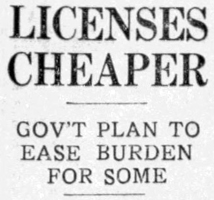 |
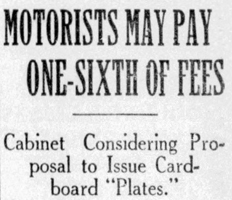 |
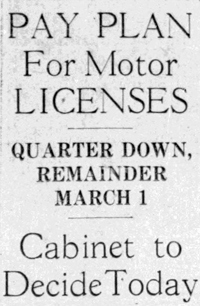 |
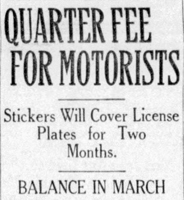 |
Throughout the week of December 23-28, as the 1932 registration year wound down and motorists contemplated what to do with their vehicles, the local press dutifully reported on the Cabinet's deliberations about whether to extend the licensing year (or not).
|
|||
On December 28, 1932, it was formally announced that motorists would only be required to pay one-quarter of the annual license on January 1st with the remainder due on March 1st, and that the licensing year would now run from March 1st. It was further announced (incorrectly) that motorists would be required to attach a sticker to their license plates between January 1st and March 1st as proof of having paid their quarterly fee. To further incentive motorists, the province did away with the quarterly reduction in licensing fees. On December 30, 1932, the Tolmie government signed an Order in Council to formalize the scheme and tasked the King's Printer with the Herculean task of preparing the necessary receipts and stickers to be placed on windshield (not license plates) for issuance two days later on January 1, 1933. In what must have been an amazing feat of self-less effort and dedication by the workers at the King's Printer, the windshield stickers were arriving at motor vehicle offices around the province by January 4, 1933. The full story of these windshield stickers can't fairly be fit onto this page, so we have set-up a separate page that can be found by Clicking Here! While the image of the truck windshield below shows an official looking form in the left corner (with the white background), we here at BCpl8s.ca have never seen one of these stickers and can only assume it looked something like this. We hope one will surface (soon). |

| The "Lost in Oakalla" Plates |
By the end of 1932, there were approximately 30,000 un-issued sets of license plates, representing 25% of the total order and a colossal waste of public resources in very tough economic times. While we shudder to think how many of these license plates were consigned to the "Graveyard" somewhere off Atkinson Point, an unknown number were packed between a wall at Oakalla and forgotten about. The main cellblock at Oakalla Prison had been constructed between 1912 and 1915, and other additions were subsequently added to the complex over the next 50 years, including the Westgate Annex which had been constructed between 1963 and 1964 and housed the Plate Shop, shoe repair shop, tailor shop and warehouse space. Prior to being relocated to the Westgate Annex, the Plate Shop had resided elsewhere in the prison (where, we here at BCpl8s.ca do not exactly know) and when Oakalla was eventually demolished in 1991, the province brought in specialised contractors who, in taking the structure apart, found the boxes of unissued 1932 license plates, all of which were 6-digit. These plates are easily identifiable by the water damage resulting from 60 years behind a damp wall: |
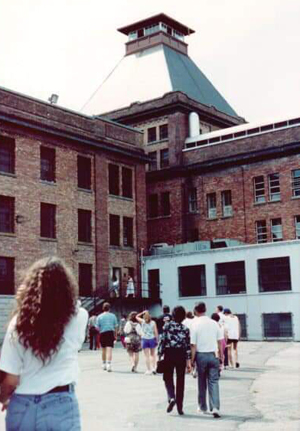 |
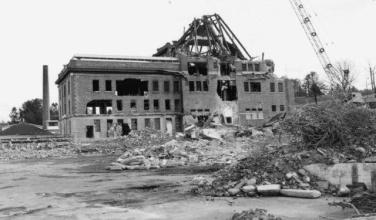 |
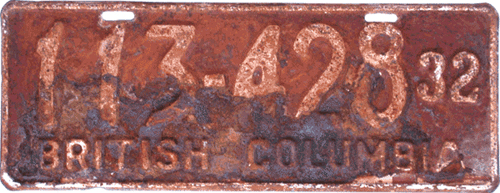 |
|
Shown
above-top is Oakalla Prison being demolished in 1991. Above is a typical 1932 "lost in Oakalla" plate. |
The so-called "Escape to Oakalla" weekend included a McDonald's children's "pen" where the kiddies could make their own license plates! Given the equipment from the Oakalla Plate Shop had been sold to Astrographic Industries Limited in 1984 (see 1985-2001), and was totally unsafe for public use, we suspect that these "license plates" were merely colouring pages. |
* * * * * |
The local newspapers proclaimed that "there's nothing depressing about the new plates" as the colours "will add a touch of gaiety to the general colour scheme of street and highway traffic ... In fact, staid motorists may experience an unpleasant shock when they see" the new plates. |
| 1933 | |||||||||||||||||||||||
|
|||||||||||||||||||||||
Over a third of this total, about $6,563, was attributable to the work of prisoners in the Plate Shop. Other sources of revenue came from the prison farm and work clearing land and assisting with road construction. |
Despite the changes to the licensing year and annual fees, the number of registered vehicles in British Columbia declined again in 1933, ending at 87,108, which was 10,000 less vehicles than had been registered in 1930 (97,586). |
* * * * * |

For motorists that had paid their license fees prior to March 1st of 1933, they would be receiving another windshield sticker by mail from the Provincial Police allowing them to use their 1933 license plates through to March 1st of 1934. It was estimated that 56,000 stickers were to be sent out by post. For those who had registered their vehicle after March 1, 1933, they would be provided the same windshield stickers once they had paid at least a one-sixth fee for 1934. This was the last year that a windshield sticker was to be used and in 1935 "all licenses [were to] be payable in the ordinary way on March 1." |
| 1934 | |||||||||||||||||||||||
1-digit |
|
||||||||||||||||||||||
For the first time since 1930, total vehicle registrations increased in 1934, by almost 4% or to approximately 90,526 vehicles, and within close distance to the total number of license plates manufactured at Oakalla (being 92,000). |
* * * * * |
Unlike in previous years, the plates would be made available on February 1st, as opposed to December 1st, which caused some confusion. Also unlike previous years, the plates could be used as soon as they were issued (no waiting a month to put them on) if 1934 drivers' licenses were displayed on the dashboard of the car. it was reported that "a set of plates weighs nearly a pound" and, at the Vancouver Courthouse, "more than seventeen tons of plates, representing 35,150 numbers, are locked up in the department's vaults." With the legislative changes previously enacted to change the registration year to March 1st, motorists were advised that the two week grace period to mid-January the police had usually allowed for new plates to be obtained was a thing of the past and enforcement would begin immediately on the first day of March. |
| 1935 | |||||||||||||||||||||||
1-digit |
2-digit |
|
|||||||||||||||||||||
With the growth in vehicle numbers in 1934, the Provincial Police estimated demand in 1935 would increase by 6.7% and manufactured 96,000 pairs of license plates to meet this. By the end of the year, demand had increased by 7.6% and the province was forced to order an estimated 9,000 additional pairs of license plates, pushing plate numbers back into 6-digits again. The 6-digit plates were accommodated on a longer base than what was used for the 5-digit plates, which added cost to manufacturing process and would influence the design of the 1936 plates ... |
Quick Links: |
|
© Copyright Christopher John Garrish. All rights reserved.


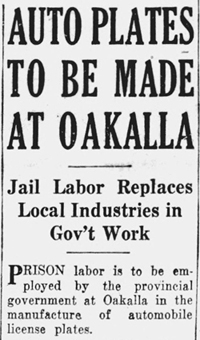 On January 10, 1930, a mere ten days into the new registration year when many motorists had still not replaced their license plates, the Vancouver Sun broke a story that the provincial government was bringing the manufacturing of license plates "in-house" by establishing a production facility at Oakalla Prison in Burnaby.
On January 10, 1930, a mere ten days into the new registration year when many motorists had still not replaced their license plates, the Vancouver Sun broke a story that the provincial government was bringing the manufacturing of license plates "in-house" by establishing a production facility at Oakalla Prison in Burnaby.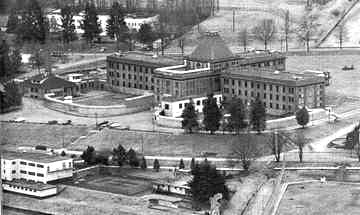 Thanks to a Letter to the Editor in May of 1930 entitled "An Ex-Convict Speaks", the writer (using the pen name "Free") provides a very brief insight into the establishment of the Plate Shop at Oakalla.
Thanks to a Letter to the Editor in May of 1930 entitled "An Ex-Convict Speaks", the writer (using the pen name "Free") provides a very brief insight into the establishment of the Plate Shop at Oakalla.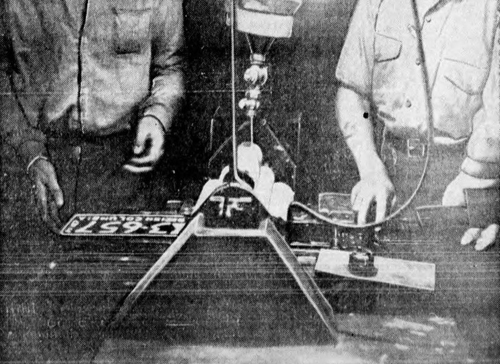 As can be seen in the image at right, taken at the Oakalla Plate Shop in 1937, the equipment acquired from Tacey was very rudimentary by modern standards.
As can be seen in the image at right, taken at the Oakalla Plate Shop in 1937, the equipment acquired from Tacey was very rudimentary by modern standards. 
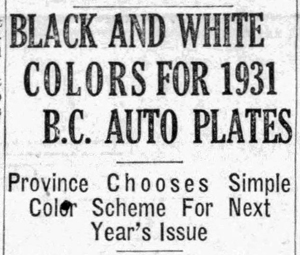 With the transfer of production to Oakalla, the annual release of the Tender for license production ceased. What did not cease, however, was use of the J.R. Tacey & Son dies. Tacey's slanted dies re-appeared in 1931 while the straight dies were used again between 1933 and 1935. This is not at all surprising given the acquisition of Tacey's equipment by the province.
With the transfer of production to Oakalla, the annual release of the Tender for license production ceased. What did not cease, however, was use of the J.R. Tacey & Son dies. Tacey's slanted dies re-appeared in 1931 while the straight dies were used again between 1933 and 1935. This is not at all surprising given the acquisition of Tacey's equipment by the province.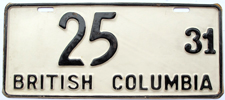
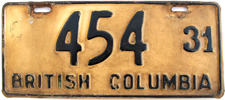
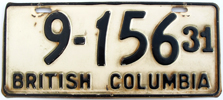
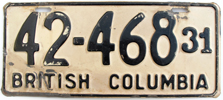
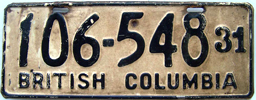
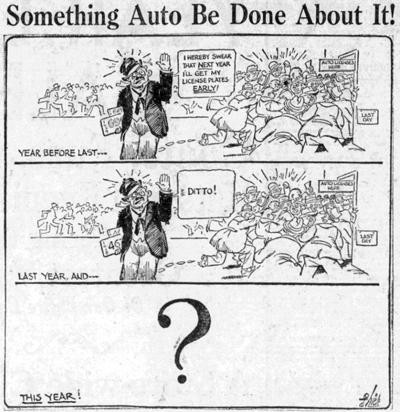
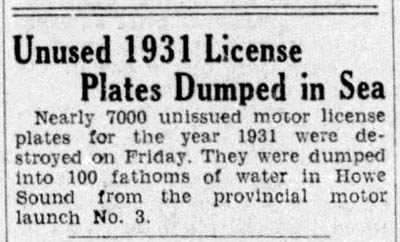 By the end of the year, the province was left with almost 7,000 unissued 1931 license plates as motorists took their cars of the road to save costs - which equated to about 7% of the total license plate order for that year.
By the end of the year, the province was left with almost 7,000 unissued 1931 license plates as motorists took their cars of the road to save costs - which equated to about 7% of the total license plate order for that year.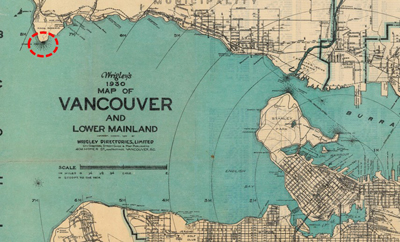
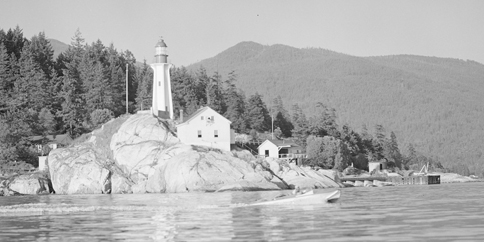
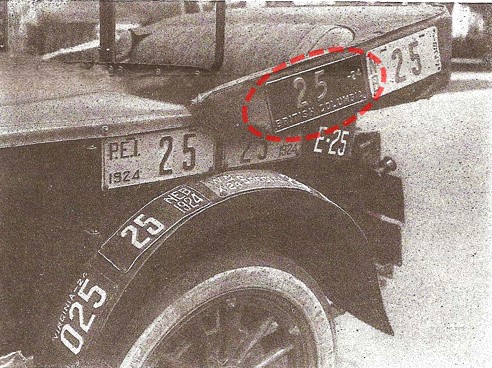 In the 1920s and 1930s, British Columbia issued 2 sets of No. 25 license plates; one set to a local motorist who actually lived in the province and the second set to Charles Henry Davis of Massachusetts. Shown at left is the 1924 BC No. 25 affixed to Davis' vehicle.
In the 1920s and 1930s, British Columbia issued 2 sets of No. 25 license plates; one set to a local motorist who actually lived in the province and the second set to Charles Henry Davis of Massachusetts. Shown at left is the 1924 BC No. 25 affixed to Davis' vehicle.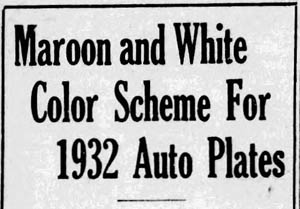 On November 21, 1931, it was reported that the 1932 license plates would be available from the Vancouver Courthouse on December 1st for purchase but were not to be affixed to a car until January 1, 1932 (newly registered cars could have plates affixed to them starting December 24, 1931).
On November 21, 1931, it was reported that the 1932 license plates would be available from the Vancouver Courthouse on December 1st for purchase but were not to be affixed to a car until January 1, 1932 (newly registered cars could have plates affixed to them starting December 24, 1931).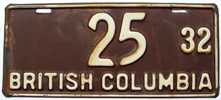
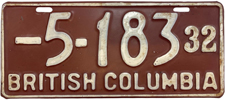
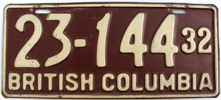
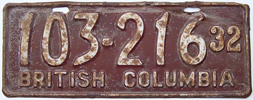
 Following lobbying efforts by the British Columbia Automobile Association (BCAA), the province ultimately agreed to move forward the date that a full year license could be obtained at a 25% discount from March 31st to March 15th.
Following lobbying efforts by the British Columbia Automobile Association (BCAA), the province ultimately agreed to move forward the date that a full year license could be obtained at a 25% discount from March 31st to March 15th.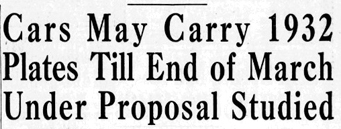 By the end of 1932, registrations were down approximately 7% from the previous year, with almost 6,840 less vehicles on the road, a trend that was playing out across Western Canada.
By the end of 1932, registrations were down approximately 7% from the previous year, with almost 6,840 less vehicles on the road, a trend that was playing out across Western Canada.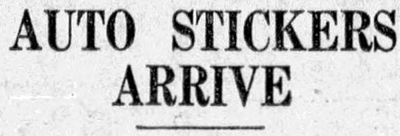
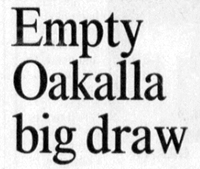 As can be seen in the photo above (left), the gates to Oakalla were thrown open to the public in July of 1991 so they could get a last look at the prison before the wrecking crews moved in.
As can be seen in the photo above (left), the gates to Oakalla were thrown open to the public in July of 1991 so they could get a last look at the prison before the wrecking crews moved in.
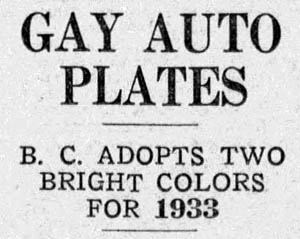 The 1933 license plates started arriving at the offices of the Motor Vehicle Branch in early October of 1932 with the colours described as "maroon figures against a background of buff". If you are curious like us, "Buff (latin bubalinus) is a light brownish yellow, ochreous colour ..." and describes the plates very accurately.
The 1933 license plates started arriving at the offices of the Motor Vehicle Branch in early October of 1932 with the colours described as "maroon figures against a background of buff". If you are curious like us, "Buff (latin bubalinus) is a light brownish yellow, ochreous colour ..." and describes the plates very accurately.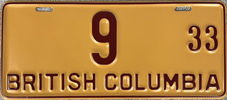
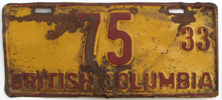
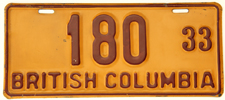
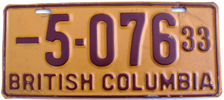
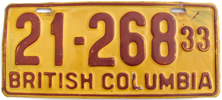
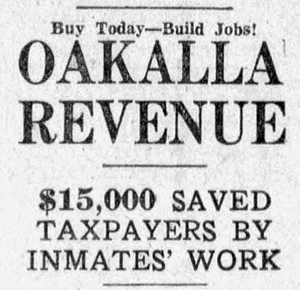 Obviously still smarting over the move to take license plate production away from private industry and have it made by prison labour, Attorney General Pooley announced that, in the fiscal year ending March 31, 1932, "inmates' work" had saved taxpayers over $15,000.
Obviously still smarting over the move to take license plate production away from private industry and have it made by prison labour, Attorney General Pooley announced that, in the fiscal year ending March 31, 1932, "inmates' work" had saved taxpayers over $15,000.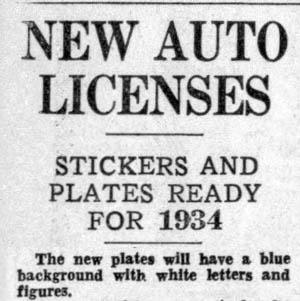 On November 20, 1933, it was announced that the colour of the 1934 license plates would be white-on-blue and would not be issued for until February 1, 1934 and were not to be used until March 1, 1934.
On November 20, 1933, it was announced that the colour of the 1934 license plates would be white-on-blue and would not be issued for until February 1, 1934 and were not to be used until March 1, 1934.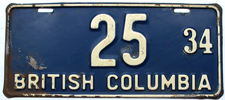
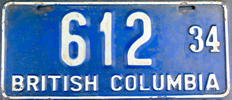
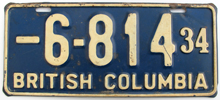
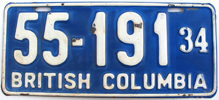
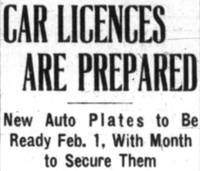 On December 15, 1934, it was announced that the colour of the 1935 license plates would be the reverse of the current year's plates, so blue numerals on a white background.
On December 15, 1934, it was announced that the colour of the 1935 license plates would be the reverse of the current year's plates, so blue numerals on a white background.